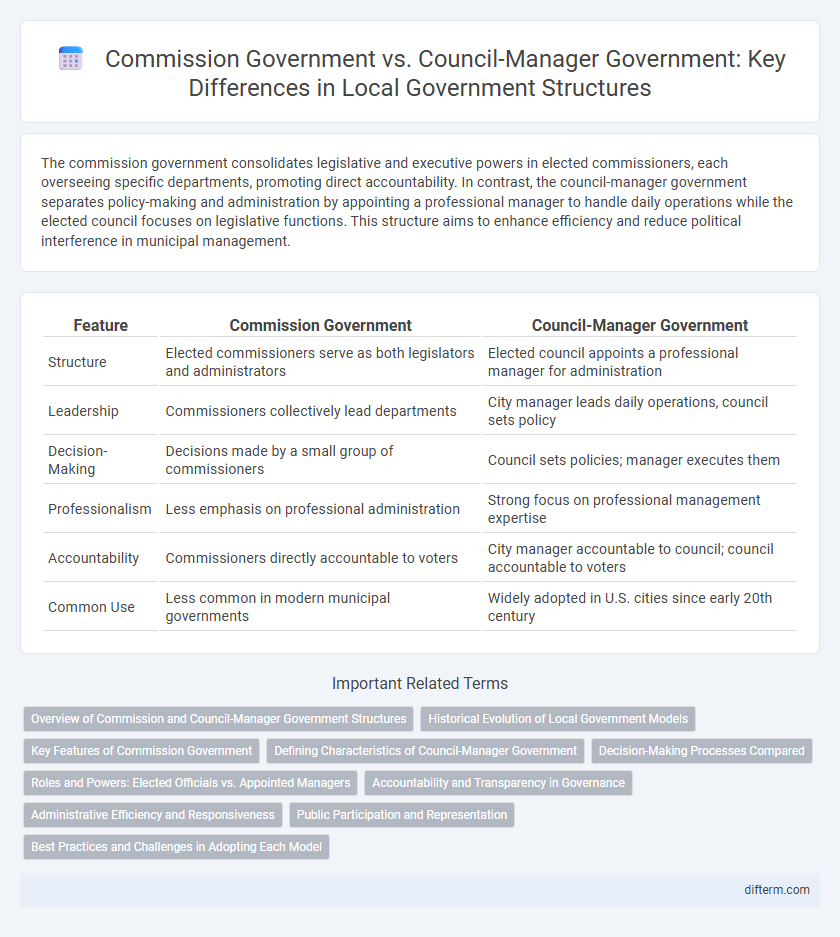The commission government consolidates legislative and executive powers in elected commissioners, each overseeing specific departments, promoting direct accountability. In contrast, the council-manager government separates policy-making and administration by appointing a professional manager to handle daily operations while the elected council focuses on legislative functions. This structure aims to enhance efficiency and reduce political interference in municipal management.
Table of Comparison
| Feature | Commission Government | Council-Manager Government |
|---|---|---|
| Structure | Elected commissioners serve as both legislators and administrators | Elected council appoints a professional manager for administration |
| Leadership | Commissioners collectively lead departments | City manager leads daily operations, council sets policy |
| Decision-Making | Decisions made by a small group of commissioners | Council sets policies; manager executes them |
| Professionalism | Less emphasis on professional administration | Strong focus on professional management expertise |
| Accountability | Commissioners directly accountable to voters | City manager accountable to council; council accountable to voters |
| Common Use | Less common in modern municipal governments | Widely adopted in U.S. cities since early 20th century |
Overview of Commission and Council-Manager Government Structures
Commission government features elected commissioners who collectively serve as the legislative body and individually oversee specific city departments, combining executive and legislative functions. Council-manager government separates powers, with an elected council responsible for policy-making and a professional city manager appointed to handle administrative operations. This structure emphasizes efficiency and professionalism by entrusting daily management to a trained administrator while elected officials focus on legislation and community representation.
Historical Evolution of Local Government Models
The historical evolution of local government models highlights the commission government emerging in the early 20th century as a response to inefficiencies in urban management, characterized by elected commissioners each overseeing specific departments. The council-manager government evolved later, gaining prominence due to its blend of political leadership from elected councils with professional expertise provided by an appointed city manager, aiming for efficient administration and reduced corruption. These models reflect shifting priorities in governance structures used to address urban growth and demands for accountability in local government.
Key Features of Commission Government
Commission government features a small elected body serving as both legislative and executive authority, with commissioners overseeing specific departments such as public safety, finance, or public works. This system emphasizes direct accountability as each commissioner is responsible for their department's operations and policy implementation. Often employed in smaller municipalities, commission government promotes streamlined decision-making but may face challenges in coordination across functions.
Defining Characteristics of Council-Manager Government
The council-manager government features an elected council responsible for legislative functions and policy-making, while a professional city manager handles administrative operations, ensuring efficient and impartial management. This structure separates political leadership from administrative expertise, promoting accountability and professional governance. The city manager is appointed by the council and serves as the chief executive officer, implementing council policies and overseeing daily government activities.
Decision-Making Processes Compared
In commission government, decision-making processes are centralized within elected commissioners who collectively hold both legislative and executive powers, enabling direct control over specific departments. Council-manager government separates legislative and executive functions, where the elected council sets policies and appoints a professional manager to implement decisions and oversee daily operations. This division enhances efficiency by delegating administrative expertise to the manager, while the council focuses on policy and representation.
Roles and Powers: Elected Officials vs. Appointed Managers
Commission government vests legislative and executive powers in elected commissioners who both set policies and oversee departments directly, enhancing political accountability but risking inefficiency. Council-manager government separates roles by empowering elected councils to set policy while appointing professional managers to execute decisions and administer daily operations, promoting expertise and operational efficiency. This delineation balances political representation with administrative proficiency, optimizing governance outcomes.
Accountability and Transparency in Governance
In commission government, accountability is concentrated as elected commissioners directly oversee specific departments, making it easier for citizens to identify responsible officials, but transparency can suffer due to limited checks and balances among commissioners. Council-manager government distributes accountability between the elected council, which sets policies, and the appointed city manager, who implements them, enhancing transparency through professional administration and clearer separation of political and operational roles. Studies show council-manager systems tend to foster higher transparency and more consistent accountability, contributing to improved public trust and efficient governance outcomes.
Administrative Efficiency and Responsiveness
The commission government consolidates legislative and executive functions within elected commissioners, streamlining decision-making but often limiting specialized administrative expertise. In contrast, the council-manager government separates policy-making and administration by appointing a professional city manager, enhancing administrative efficiency through expert management and allowing elected officials to focus on responsiveness to public concerns. Empirical studies show council-manager models typically achieve faster implementation of policies and greater adaptability to community needs compared to commission governments.
Public Participation and Representation
In commission government, elected commissioners simultaneously serve legislative and executive functions, which can limit direct public participation due to concentrated decision-making authority. Council-manager government separates policy-making and administrative operations, enabling broader public representation as the council, elected by citizens, focuses on legislation while a professional manager handles daily operations. This structure typically fosters enhanced citizen engagement and responsiveness through a clearer division of roles.
Best Practices and Challenges in Adopting Each Model
Commission government centralizes legislative and executive powers within elected commissioners, facilitating direct accountability but often facing challenges in role confusion and inefficiency. Council-manager government separates policymaking and administration, promoting professional management and operational expertise while encountering difficulties in political-manager relations and potential democratic deficits. Best practices include clear role definitions, ongoing training, and community engagement to enhance transparency and responsiveness in both models.
commission government vs council-manager government Infographic

 difterm.com
difterm.com